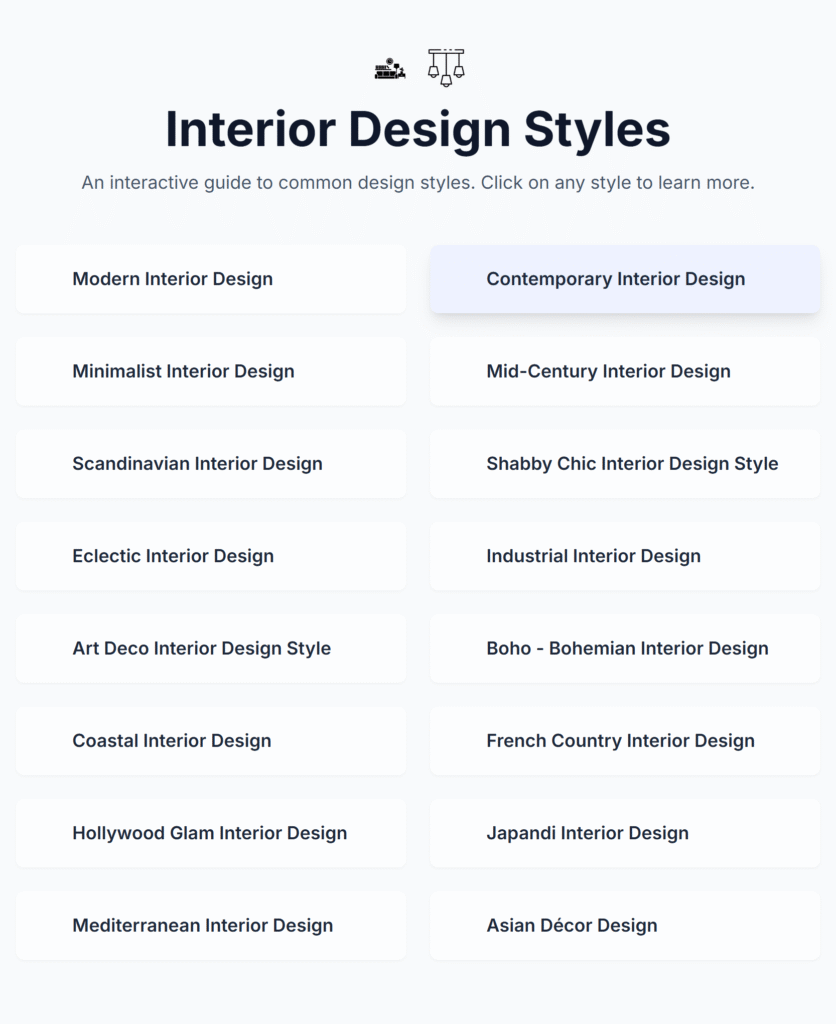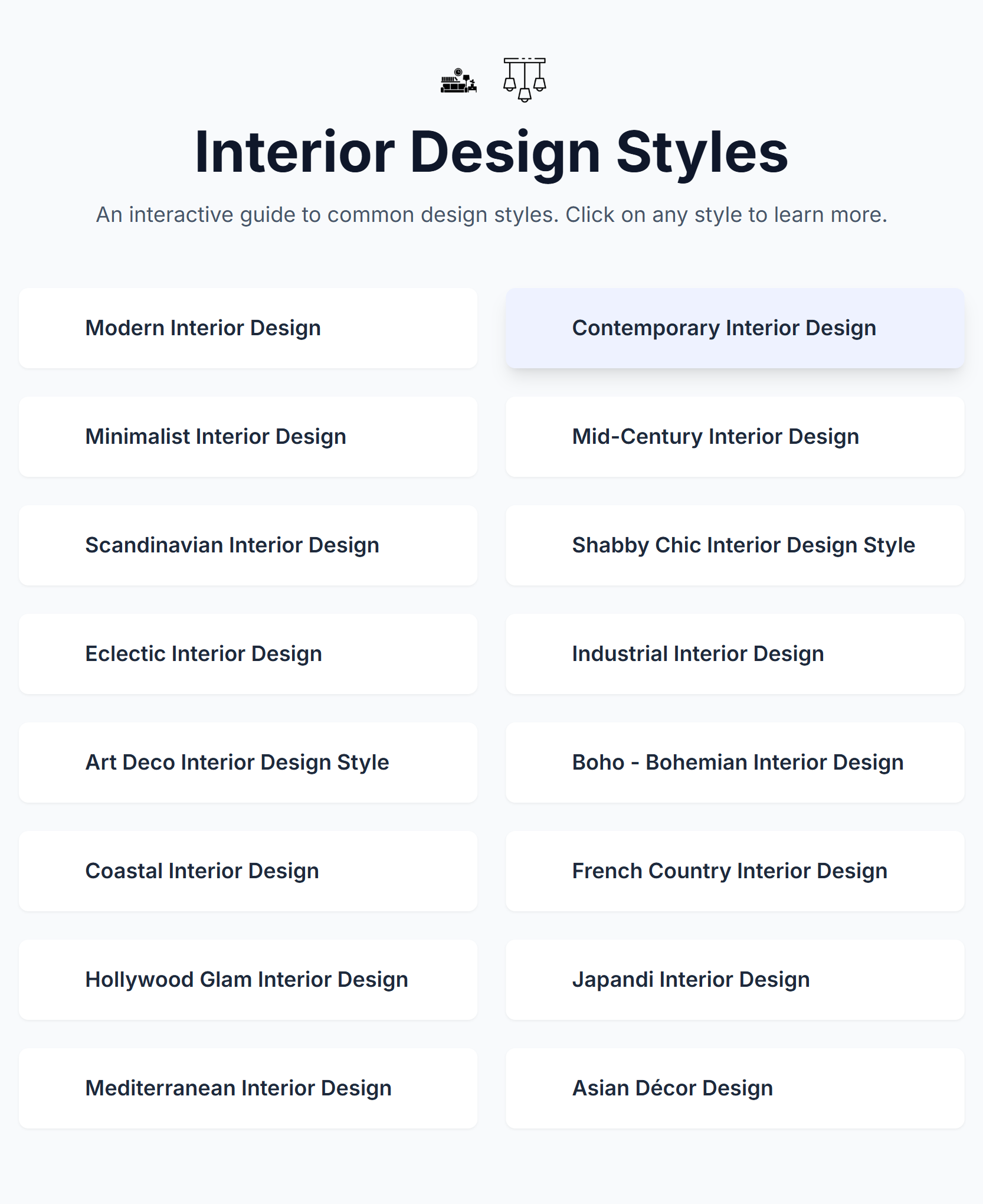Ever stood in a furniture store, heart racing, wondering why everything looks so familiar yet so different? Interior design styles are like fashion seasons for our homes — each has its personality, rules, and secret sauce. Whether you’re redecorating a single room or rehabbing a whole house, knowing the language of styles saves time, money, and a lot of second-guessing.
This guide walks you through 15+ popular interior design styles — from Modern to Japandi — breaking each down into what it looks like, why people love it, and how to get the vibe without starting from scratch. Think of this as your cheat sheet and inspiration board in one.

How to Choose an Interior Design Style
Picking a style isn’t a one-size-fits-all decision. Ask three honest questions first: What’s your lifestyle? What’s your budget? How permanent do you want the changes to be?
Start with Lifestyle
Do you love hosting lively dinners, or is quiet, cozy reading more your jam? If you entertain, durable fabrics and flexible seating matter. If you’re a homebody, comfort and calm might come first.
Consider Space & Budget
Small spaces benefit from light, minimal styles (hello, Scandinavian). Tight budgets can lean on paint, textiles, and thrifted accents to create impact.
Mix with Confidence
You don’t need to be loyal to a single style. The best rooms borrow — anchor one style and sprinkle elements from others. The trick is cohesion (repeat a color or material).
Modern Interior Design
Key Characteristics
Sleek lines, uncluttered spaces, functional furniture. Modern design celebrates form following function. It often uses geometric shapes and open floor plans.
Color Palette & Materials
Neutral bases like grays, whites, and blacks with occasional bold accents. Materials include metal, glass, and engineered wood.
Styling Tips
Invest in one or two sculptural pieces — a modern sofa or coffee table can anchor the room. Keep accessories minimal and curated.
Contemporary Interior Design
What Sets It Apart
Often confused with modern, contemporary is more fluid — it reflects what’s current now. Expect rounded edges, sustainable materials, and a blend of soft and sharp lines.
Furniture & Flow
Comfort-first seating, flexible layouts, and updated classics. Contemporary rooms feel effortless and lived-in.
Minimalist Interior Design
Principles
Less is more — but it’s not about emptiness. Minimalism focuses on essentials, quality over quantity, and negative space.
Declutter Tricks
Use built-in storage, uniform containers, and a strict “one-in-one-out” rule for possessions. If it doesn’t serve a purpose or spark joy, reconsider it.
Mid-Century Interior Design
Signature Pieces
Think Eames chairs, teak sideboards, and tapered legs. Mid-century brings warmth and sculptural charisma.
How to Modernize
Add contemporary lighting and neutral textiles to keep the look fresh. Mix vintage and new for authenticity.
Scandinavian Interior Design
Light & Functionality
Scandi style is about light, airy spaces. White walls, natural light, and functional layouts dominate.
Cozy Elements
Introduce texture with wool throws, sheepskin rugs, and simple ceramics. It’s minimal but soft — hygge vibes included.
Shabby Chic Interior Design
Vintage Vibes
Shabby chic loves weathered finishes, soft florals, and pastel palettes. It’s feminine, romantic, and intentionally imperfect.
Where to Source Pieces
Thrift stores, flea markets, and upcycling are your friends. Sand, paint, and reupholster to make things look lovingly worn.
Eclectic Interior Design
Rules for Mixing
Eclectic is curated chaos. The only rule is cohesion: pick a unifying thread (color, texture, or era).
Creating Visual Harmony
Use repeating colors or a recurring material like brass or rattan to tie diverse pieces together.
Industrial Interior Design
Raw Materials
Exposed brick, concrete, and metal fixtures are the backbone of industrial style. It’s a nod to factories and loft living.
Softening the Look
Add warmth with wood furniture, soft rugs, and warm lighting so the space doesn’t feel cold or sterile.
Art Deco Interior Design
Glamorous Touches
Art Deco is bold: geometric patterns, luxe materials (velvet, lacquer), and metallic accents.
Using Patterns & Metals
Introduce mirrored furniture, sunburst motifs, and gold or brass hardware for instant drama.
Boho (Bohemian) Interior Design
Layering Textures
Boho is about layers — layered rugs, mixed prints, and abundant textiles. It feels collected, not curated.
Plants & Patterns
Jungle of plants, global textiles, and handmade ceramics. Boho is carefree, creative, and endlessly personal.
Coastal Interior Design
Breezy Color Schemes
Blues, sandy neutrals, and sea-glass greens. Coastal is light, airy, and relaxed.
Materials That Work
Linen, wicker, driftwood, and washed woods. Keep things casual; let the light do the heavy lifting.
French Country Interior Design
Rustic Elegance
Warm colors, distressed wood, and classic patterns (toiles and checks). It’s rustic, but with polish.
Key Fabrics & Finishes
Linen curtains, wrought iron fixtures, and painted cabinets with soft distressing.
Hollywood Glam Interior Design
Luxurious Statements
Plush velvet, dramatic lighting, and mirrored surfaces. Hollywood Glam is unapologetically opulent.
Lighting & Mirrors
Think layered lighting (chandeliers + lamps) and oversized mirrors to amplify the wow factor.
Japandi Interior Design
East Meets Nordic
Japandi blends Japanese simplicity with Scandinavian warmth — minimal, functional, and serene.
Minimal Warmth
Natural woods, low profiles, and a muted palette. It’s minimalism with a human touch.
Mediterranean Interior Design
Earthy Palettes
Terracotta, deep blues, and sun-baked neutrals. Mediterranean style feels like a permanent vacation.
Tile & Texture
Hand-painted tiles, stucco walls, and textured plaster add tactile richness.
Asian Décor Design
Balance & Symbolism
Asian-inspired interiors often emphasize balance, feng shui principles, and natural materials.
Natural Materials
Bamboo, teak, rice paper lamps, and stone — these elements create calm, intentional spaces.
Quick Comparison & Cheat Sheet
Sometimes you need a fast path to decide. Here’s a tiny cheat sheet:
Best for Small Spaces
Scandinavian, Minimalist, Japandi — they emphasize light, function, and fewer furnishings.
Best for Entertaining
Modern, Contemporary, Hollywood Glam — open layouts and statement seating work well.
Best for Low Budget
Shabby Chic (upcycling), Boho (layering inexpensive textiles), and Industrial (repurposed materials).
Tips for Mixing Styles Successfully
Mixing styles can create unique, personal spaces if you follow a few reliable tricks.
Anchor with Color
Pick a main color palette and repeat it across different elements. Color repetition makes eclectic choices feel intentional.
Repeat Materials
Repeating a material (wood, brass, rattan) helps disparate pieces speak the same design language.
Practical Styling Hacks (Quick Wins)
- Paint is magical: a new wall color refreshes a room faster than any other change.
- Textiles transform: swap pillow covers and throws seasonally for new moods.
- Scale matters: balance large furniture with large art; small pieces get lost.
- Layer lighting: ambient + task + accent = a room that feels finished.
Conclusion
Interior design styles are tools, not rules. Think of them like flavors — you don’t have to stick to one; combine responsibly and taste-test as you go. Start with your lifestyle, pick a few signature pieces that sing to you, and use color and materials as glue. The best-designed spaces are the ones that make you feel at home, not the ones that look like a showroom.
FAQs
Q1: How do I pick a style if I like several at once?
A: Anchor with one dominant style and borrow accents from others. Use a unifying color or material to keep things cohesive.
Q2: Can I change my interior style without replacing big furniture?
A: Absolutely. Paint, lighting, rugs, and throw pillows can dramatically shift a room’s vibe at a fraction of the cost.
Q3: What style is best for small apartments?
A: Scandinavian, Minimalist, or Japandi — they prioritize light, storage solutions, and uncluttered layouts.
Q4: How do I make a room feel more luxurious without spending much?
A: Focus on texture and lighting: plush throws, layered rugs, and well-placed lamps create depth and perceived luxury.
Q5: How can I mix modern and vintage pieces successfully?
A: Use repetition (color or material) and scale. A modern sofa can pair beautifully with a vintage side table if the palette or metal finish repeats elsewhere in the room.

